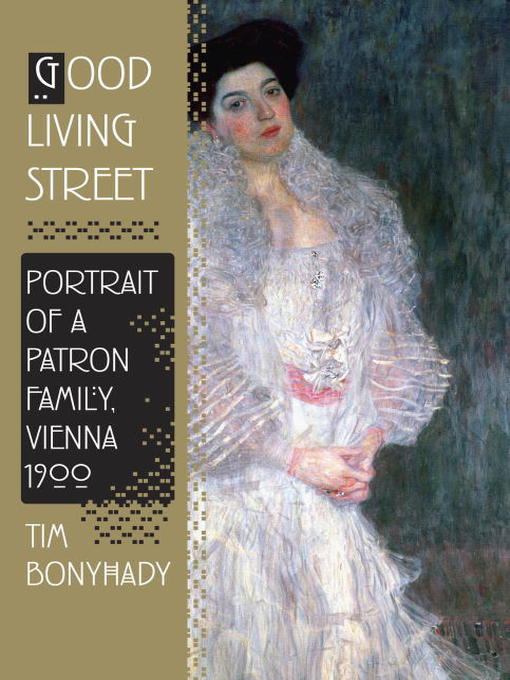
Good Living Street
Portrait of a Patron Family, Vienna 1900
کتاب های مرتبط
- اطلاعات
- نقد و بررسی
- دیدگاه کاربران
نقد و بررسی

September 5, 2011
This disquieting family saga begins in early 20th-century Vienna and ends in Sydney, Australia, portraying through three generations of the author’s family the patriotism, conservatism, and love of culture among Viennese Jewish haute bourgeoisie and their dispersal after the Nazi Anschluss in 1938. The section on the author’s maternal great-grandparents, Moritz and Hermine Gallia, is the book’s highlight. The Gallias, Jews who had converted to Catholicism, were patrons of Vienna’s modern artists, including Gustav Klimt (who painted Hermine’s portrait) and the art and design group Wiener Werkstätte. The descriptions of the early years of the Holocaust in Austria, as seen through the Gallias’ eyes, are vivid, including daughter Käthe’s arrest and interrogation by the Nazis (who knew of the family’s Jewish origins). Käthe and her older sister, Gretl, eventually fled to Australia; Gretl’s daughter Anne is the author’s mother. Bonyhady, an art historian and environmental lawyer in Australia, sticks so closely to the family story that he stints on historical context (e.g., he writes, “the Australian Jewish Welfare Society was ambivalent about Jewish refugees fleeing the Nazis,” without further explanation). Still, Bonyhady’s book does a real service by unearthing the story of a prominent Jewish family during Vienna’s artistic flowering and the impact of WWII. 8 pages of color photos, b&w photos.

September 15, 2011
Australian art historian Bonyhady (Words for Country: Landscape & Language in Australia, 2001, etc.) revisits the lives and collections of several generations of his family, members of whom had to flee the Nazis.
When the Nazis swooped into Vienna, the author's grandmother, grandaunt and mother escaped the country with "the best private collection of art and design to escape Nazi Austria." As a boy, the author saw some of this in Sydney and, later, was inspired to research and write the story of the women, only one of whom, his mother, remained alive. And she was reluctant to revisit her life. Bonyhady proceeds chronologically, relating the history of Jews in Vienna, the cultural ambiance of the city and the genesis of the fortune accumulated by his great-grandparents, a fortune enjoyed and increased until the worldwide depression and the Nazis fractured it. Members of his family were friends with Mahler, collected the works of Gustav Klimt, lived in spaces designed by Josef Hoffmann and experienced luxury and comfort unknown to most Viennese. Their neighborhood included Wohllebengasse, the street whose name in English translation forms Bonyhady's title. Although the author spends some space cataloging his family's possessions (and they were impressive), he confesses, too, that such wealth embarrasses him. The author was fortunate that these women were fairly fastidious about keeping diaries and letters and programs to the opera and such, and he mines them assiduously for material. He tells of love affairs (licit and otherwise) and marriages (successful and otherwise) and saves the real excitement for the women's escape from Europe in 1938, their resettlement in Australia, their adjustment to a more austere life and the sales of their possessions.
Political, economic and art history effectively combine with memoir to create a compelling story.
(COPYRIGHT (2011) KIRKUS REVIEWS/NIELSEN BUSINESS MEDIA, INC. ALL RIGHTS RESERVED.)

November 1, 2011
Art historian and environmental lawyer Bonyhady traces his Jewish family history through the lens of its Vienna address on Wohllebengasse (Good Living Street) and reconstructs his mother's Austrian childhood and escape from the Nazi-controlled country to Sydney, Australia. The Gallia family, prominent patrons of the arts, lived in the era of Klimt, Mahler, Hoffmann, and Schiele, whose art dominates the book's beginning but recedes as the family become refugees. Klimt's portrait of Bonyhady's great-grandmother, Hermine Gallia, and an incredible collection of Wiener Werkstatte left Vienna with the family and came to Australia. Official documents sometimes contradict his mother's memories, and she discarded diaries and correspondence, obscuring her true identity, to distance herself from a difficult past. Bonyhady questions her motivations along with his family's past materialism and their obliviousness to Nazi danger. This compelling, well-researched narrative delves into the problematic nature of personal history and things left behind: records destroyed, collections dispersed, identities hidden. VERDICT As much about identity, memory, and World War II as about art collecting, this will appeal to period historians as well as genealogists tracing their own histories.--Lindsay M. King, Yale Univ. Lib., New Haven, CT
Copyright 2011 Library Journal, LLC Used with permission.

October 1, 2011
Identity, like art, is beset by continually shifting cultural constructions and reinterpretations. Nowhere was this more evident than in the melting pot that was fin de si'cle Vienna. In a dynamic cultural milieu that was home to Mahler, Klimt, and Freud, the Gallias family rose from humble middle-class origins to a position of prominent bourgeois patrons standing at the center of artistic expansion. However, as assimilated Jews in the city of Wagner and anti-Semitic mayor Karl Lueger, the family retained an outsider status that no degree of material consumption or religious conversion could overcome. The 1938 Nazi annexation of Austria forced family members Gretl, Kathe, and Anne to not only flee the country but also reconstruct new identities as immigrant aliens in Australia. Bonyhady has delved deeply into his forebears' concert books, travel logs, letters, and death certificates in an effort to reconstruct his family's identity and, for his mother, to place a value on her life that she did not. The result is a lucid, poignant generational tale of loss of material wealth and cultural identity that provides new perspective and insight into both Holocaust and immigration studies.(Reprinted with permission of Booklist, copyright 2011, American Library Association.)

























دیدگاه کاربران